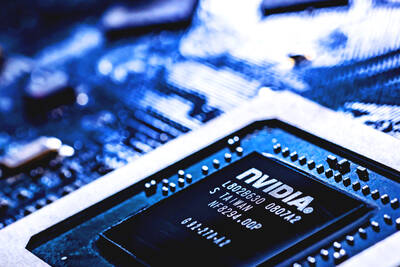Siliconware Precision Industries Co (SPIL, 矽品), the nation’s second-largest chip packager and tester, yesterday said earnings plunged 37 percent as appreciating local currency and rising key raw material prices eroded margins, but the company offered a better outlook for the current quarter than its peers.
The growth would be primarily supported by demand in emerging markets, company chairman Lin Wen-po (林文伯) told investors. However, Lin worried that persistent global economic weakness could hurt consumer purchasing power in developing countries later in the year.
Net income fell 37 percent to NT$2.41 billion (US$78 million) in the April-June quarter, compared with NT$3.83 billion in the same period last year, a company statement said.
Operating margin shrank to 15 percent last quarter from 25.2 percent a year earlier, primarily because of the appreciating New Taiwan dollar versus the greenback and rising gold prices, the company said.
The local currency has risen 6.4 percent since the beginning of the year.
Looking ahead, Lin said: “There will be mild seasonal growth in the third quarter ... We do not see any drastic decline in demand for PCs and handsets [as some thought].”
“Customers will keep their inventory at normal levels,” Lin said.
The visibility for the fourth quarter was vague, but revenues would be flat on quarterly basis, Lin said.
Revenue may grow by 4 percent to 7 percent this quarter, offsetting a 1 percent to 2 percent drop in average selling price, Lin said.
The projection is better than the low single-digit percent revenues growth projected by bigger rival Advanced Semiconductor Engineering Inc (ASE, 日月光半導體) on Tuesday.
Demand from computer customers will be the strongest among its four business segments including consumer, communications and memory chips, Lin said.
SPIL’s customers include PC graphic processor maker Nvidia Inc and local mobile phone chip supplier MediaTek Inc (聯發科).
SPIL’s operating margin may rebound to the 16 percent to 18 percent range this quarter from last quarter as local currency and gold prices have recently looked stable, Lin said.
Lin’s projection is largely in line with Citigroup analyst Andrew Lu’s (陸行之) expectations. Lu projected SPIL’s operating margin to improve to around 18 percent this quarter and revenues to expand at least 5 percent quarter on quarter, a report released yesterday said.
Lu gave a “buy” rating on SPIL with a target price of NT$66, implying a 65 percent upside in the next 12 months.
To meet customer demand, SPIL plans to keep its capital spending for this year unchanged at NT$10 billion, down 12 percent from last year’s NT$11.4 billion.

When Lika Megreladze was a child, life in her native western Georgian region of Guria revolved around tea. Her mother worked for decades as a scientist at the Soviet Union’s Institute of Tea and Subtropical Crops in the village of Anaseuli, Georgia, perfecting cultivation methods for a Georgian tea industry that supplied the bulk of the vast communist state’s brews. “When I was a child, this was only my mum’s workplace. Only later I realized that it was something big,” she said. Now, the institute lies abandoned. Yellowed papers are strewn around its decaying corridors, and a statue of Soviet founder Vladimir Lenin

UNCERTAINTIES: Exports surged 34.1% and private investment grew 7.03% to outpace expectations in the first half, although US tariffs could stall momentum The Chung-Hua Institution for Economic Research (CIER, 中華經濟研究院) yesterday raised its GDP growth forecast to 3.05 percent this year on a robust first-half performance, but warned that US tariff threats and external uncertainty could stall momentum in the second half of the year. “The first half proved exceptionally strong, allowing room for optimism,” CIER president Lien Hsien-ming (連賢明) said. “But the growth momentum may slow moving forward due to US tariffs.” The tariff threat poses definite downside risks, although the scale of the impact remains unclear given the unpredictability of US President Donald Trump’s policies, Lien said. Despite the headwinds, Taiwan is likely

UNIFYING OPPOSITION: Numerous companies have registered complaints over the potential levies, bringing together rival automakers in voicing their reservations US President Donald Trump is readying plans for industry-specific tariffs to kick in alongside his country-by-country duties in two weeks, ramping up his push to reshape the US’ standing in the global trading system by penalizing purchases from abroad. Administration officials could release details of Trump’s planned 50 percent duty on copper in the days before they are set to take effect on Friday next week, a person familiar with the matter said. That is the same date Trump’s “reciprocal” levies on products from more than 100 nations are slated to begin. Trump on Tuesday said that he is likely to impose tariffs

HELPING HAND: Approving the sale of H20s could give China the edge it needs to capture market share and become the global standard, a US representative said The US President Donald Trump administration’s decision allowing Nvidia Corp to resume shipments of its H20 artificial intelligence (AI) chips to China risks bolstering Beijing’s military capabilities and expanding its capacity to compete with the US, the head of the US House Select Committee on Strategic Competition Between the United States and the Chinese Communist Party said. “The H20, which is a cost-effective and powerful AI inference chip, far surpasses China’s indigenous capability and would therefore provide a substantial increase to China’s AI development,” committee chairman John Moolenaar, a Michigan Republican, said on Friday in a letter to US Secretary of